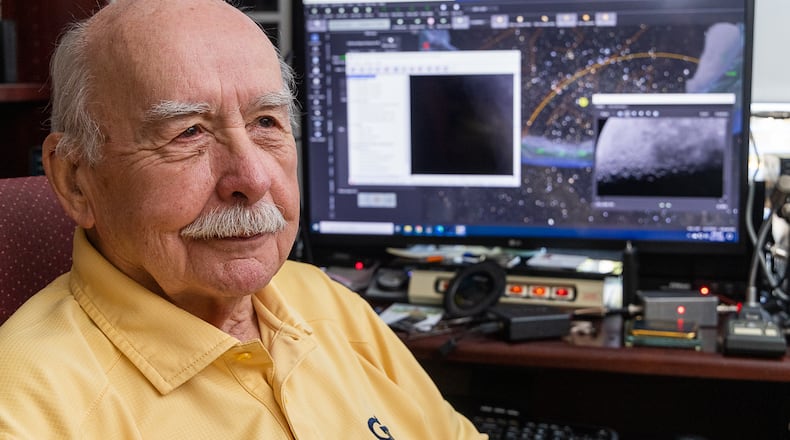Retired engineer Tom Crowley proves that you can play around with a hobby you love and see it grow into something extraordinary.
The 80-year-old has turned his love of astronomy into consulting work with the Georgia Institute of Technology’s Aloha Telescope outreach program. He operates the robotic telescope on Maui through high-speed internet connections from his home in Park Springs, a senior life plan community in Stone Mountain.
Crowley works in partnership with James Sowell, a Georgia Tech principal academic professional and astronomer in the School of Physics, and director of the university’s observatory.
Together, they’re bringing live video images of the moon into Georgia K-12 classrooms.
The oohs and ahhs they get in return are priceless.
“I tell kids this is almost as close as operating the Hubble Space Telescope or the rover on Mars,” Crowley said. “This telescope is almost a quarter of a way around the world.”
When he’s at home, Crowley runs the telescope through his computer and keeps the image online throughout the day. He also helps with maintenance, sometimes with a trip to its location at the U.S. Air Force Research Lab on Maui.
“It’s the same as if I were sitting at the telescope and using it,” Crowley said. “The fact that it’s 6,000 miles away is not a big deal. I typically get on somewhere between 1 or 2 in the morning (Hawaiian time) and run it to about 6 o’clock.”
Crowley had a long career as an electrical engineer and retired early from IBM. At age 55, he became interested in radio astronomy, studying celestial objects at radio frequencies.
Now, “it’s an obsession,” said Crowley, the past president of the Society of Amateur Radio Astronomers. “This allows me to get back to the purity of engineering.”
Sowell and Crowley met 15 years ago at the Atlanta Astronomy Club. Sowell was the guest speaker and sat across from Crowley during the dinner. Crowley offered to fix the professor’s problems with his telescopes, and they’ve been working together ever since.
“I couldn’t do this without him,” Sowell said.
Credit: Phil Skinner
Credit: Phil Skinner
The Aloha Telescope project began a decade ago after schools around the world started asking for live space images from the Georgia Tech Observatory telescope.
The first request – from a girls’ school in Australia – was challenging because of the time difference. While the students saw the images at 11 a.m., it was 11 p.m. at the observatory. Then, several months later, the telescope crew was there at 4 a.m. broadcasting to seven schools in Great Britain.
“That was when the light bulb went off, and I thought I don’t need to be the one up in the middle of the night,” Sowell said, “Georgia Tech needs to put a telescope where it’s dark, and we take advantage of it.”
It took some time to find the ideal place and time zone. Sowell wanted to keep the telescope within the United States, and the night sky in Maui was just right, clear and dark.
The Aloha Telescope is a joint project between Georgia Tech and the Air Force Research Lab, with the university providing programming and outreach. Its sole purpose is for K-12 education.
Credit: spec
Credit: spec
Sowell’s classroom presentations focus on the moon, meteorites, planetary systems, stars and the night sky. At the same time, Crowley controls the telescope via computer as if he were right there. He opens the dome, focuses on the moon and shows livestream video to the students.
While the telescope can show other space images, the moon offers the best field of view and close-ups for students to study.
Crowley will call on students to take the controls and move the telescope wherever they wish around the lunar surface. The program lasts about 50 minutes, with time for questions and answers.
In addition to the live presentations, the Georgia Tech Research Institute’s Direct to Discovery outreach program is creating a Zoom option so that multiple schools can participate at the same time.
Credit: spec
Credit: spec
“In the last few years, we’ve gotten to our stride,” Sowell said. “The kids get so excited and have all these questions.”
The most common question used to be about black holes, but in the last couple of years, it has to do with aliens, he said.
Seeing the intimate details of something so far away is thrilling, even for youths who are used to staring at screens.
“The beauty of astronomy is that so much has changed in the past few years,” Crowley said. “The James Webb Space Telescope and the information it’s giving us are destroying the paradigms we had in astronomy.
“It’s absolutely incredible to see what these space telescopes are doing.”
MORE DETAILS
The Georgia Tech Aloha Telescope Outreach Program is offered to Georgia K-12 classrooms
More information: aloha.gatech.edu; gtri.gatech.edu/d2d
About the Author
Keep Reading
The Latest
Featured




